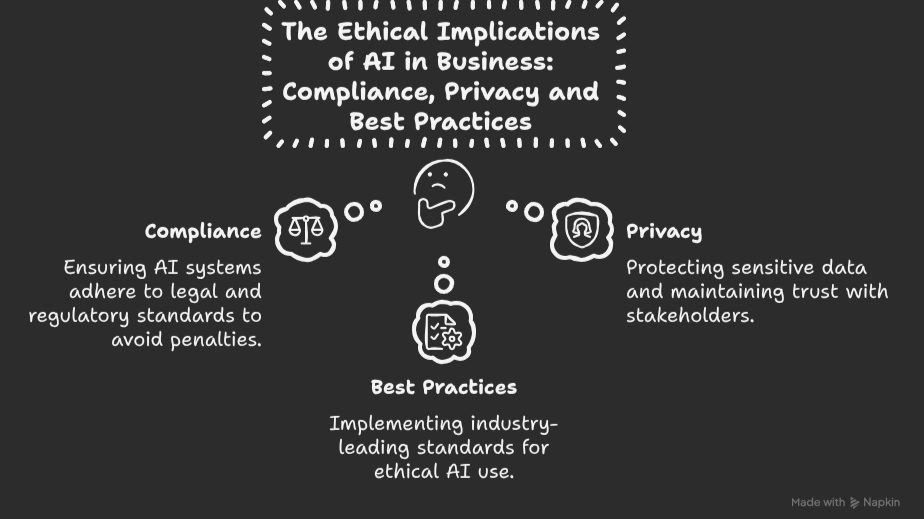Introduction: The double-edged sword of AI content
AI is everywhere—from blog posts and ad copy to product descriptions and customer emails. For businesses, it’s a game-changer: faster content production, improved personalization, and lower costs. But there’s a catch.
As more organizations rely on AI-generated content, privacy and ethics have become non-negotiable concerns. From accidentally leaking sensitive customer data to unknowingly publishing biased or plagiarized text, the risks are real. In fact, a 2023 Gartner report predicted that by 2026, 20% of enterprise content will be authored or significantly influenced by generative AI—which means mistakes in privacy and compliance could scale just as quickly.
So, how do you balance innovation with responsibility? Let’s dive into practical, human-centered strategies for ensuring your AI content practices are safe, compliant, and ethical.
Why privacy and ethics matter in AI content
Trust is your biggest asset
Your readers, customers, and stakeholders trust you to handle information responsibly. If that trust is broken—say, by misusing their data or publishing harmful content—it’s almost impossible to win back.
Regulators are paying attention
From Europe’s GDPR to California’s CCPA, data protection laws are tightening. AI adds a new layer of complexity, and companies that fail to adapt risk heavy fines or reputational damage.
AI isn’t perfect
AI models are trained on massive datasets that may include biases, errors, or even copyrighted material. Without oversight, you could unintentionally spread misinformation or violate intellectual property laws.
In short: ethics in AI content isn’t just about doing the “right thing”—it’s about protecting your business.
Common privacy and ethical risks in AI-generated content
1. Data leakage
One of the biggest concerns is feeding sensitive information into AI tools. For example, pasting customer emails or financial records into a chatbot might expose that data to third-party servers.
2. Bias in outputs
AI reflects the data it’s trained on. That means if the training set contains gender, racial, or cultural biases, those biases can appear in your content.
3. Intellectual property issues
AI-generated text can sometimes mirror copyrighted works or pull phrasing that borders on plagiarism. For businesses, this creates serious legal risks.
4. Misinformation and “hallucinations”
AI occasionally makes up facts—confidently. If published unchecked, this can spread false information and damage your credibility.
5. Transparency gaps
Many businesses don’t disclose when AI is used in content creation. While not always required legally, lack of transparency can backfire if audiences feel misled.
Safe, compliant practices for AI content
So, how do we harness AI’s benefits while avoiding the pitfalls? Let’s break it down into practical steps.
H2: Protecting privacy in AI workflows
Don’t feed sensitive data into AI tools
Never paste personal identifiers (like names, addresses, or financial details) into public AI platforms. Treat AI like a third-party vendor: only share what’s absolutely necessary.
Use enterprise-grade tools when possible
Many AI vendors now offer “enterprise” versions that prioritize privacy, encrypt data, and avoid storing prompts. For businesses, these versions are worth the investment.
Train your team on safe use
Employees are often the weakest link. A quick training session on “what not to share with AI” can prevent accidental leaks.
H2: Ensuring ethical, bias-aware content
Run outputs through human review
Never publish AI-generated text blindly. Have a human editor review for tone, inclusivity, and factual accuracy.
Diversify training data (if building custom models)
If you’re fine-tuning AI for your brand, ensure the training data is balanced and representative to reduce bias.
Use inclusive language guidelines
Maintain a brand style guide that prioritizes diversity, equity, and inclusion—and check that AI outputs align with it.
H2: Staying legally compliant
Respect copyright boundaries
AI may generate content similar to existing works. Use plagiarism checkers like Copyscape or Grammarly to ensure originality before publishing.
Follow data protection laws
Whether it’s GDPR, CCPA, or other local regulations, make sure your AI usage complies. For example, don’t use personal data in prompts without explicit consent.
Document your AI process
Keep internal records of how you use AI, what tools are involved, and what safeguards are in place. This not only improves accountability but also helps if regulators ask questions.
H2: Building transparency and trust
Disclose AI usage when appropriate
If a piece of content was heavily AI-assisted, consider mentioning it. Transparency builds credibility, especially with audiences wary of automation.
Blend AI with human expertise
AI should support—not replace—your brand’s voice. Make sure your team adds unique insights, stories, or examples that AI alone cannot provide.
Audit regularly
AI tools evolve quickly. Regular audits of your content, tools, and processes ensure you remain compliant with the latest standards and regulations.
Real-world example: When things go wrong
In 2023, a major U.S. law firm was fined after submitting a legal brief filled with AI-generated citations that didn’t exist. The lawyers trusted the AI blindly, and the error damaged both their reputation and their client’s case.
The lesson? AI is a powerful assistant, but not an autopilot. You must remain in the driver’s seat.
Conclusion: Responsible AI is competitive AI
AI content is here to stay. The businesses that will thrive aren’t just the ones using AI the fastest—but the ones using it safely, ethically, and transparently.
Here are your key takeaways:
- Protect privacy: Don’t input sensitive data into public AI tools.
- Check ethics: Review outputs for bias, inclusivity, and accuracy.
- Stay compliant: Follow copyright and data protection laws.
- Be transparent: Blend AI with human creativity and disclose usage when needed.
👉 Actionable next step: Audit your current AI workflows this week. Identify any privacy risks, set up a human review process, and update your team’s guidelines. With a few proactive steps, you can harness AI’s potential while staying firmly on the right side of ethics and compliance.
Featured Image Idea
A balanced scale illustration: one side labeled “Innovation” (with AI tools), the other “Responsibility” (with privacy & ethics), showing the importance of balance.
Social Media Caption
“AI content is powerful—but risky if you ignore privacy & ethics. 🚨 Here’s how to stay safe, compliant, and trusted: [link]”
